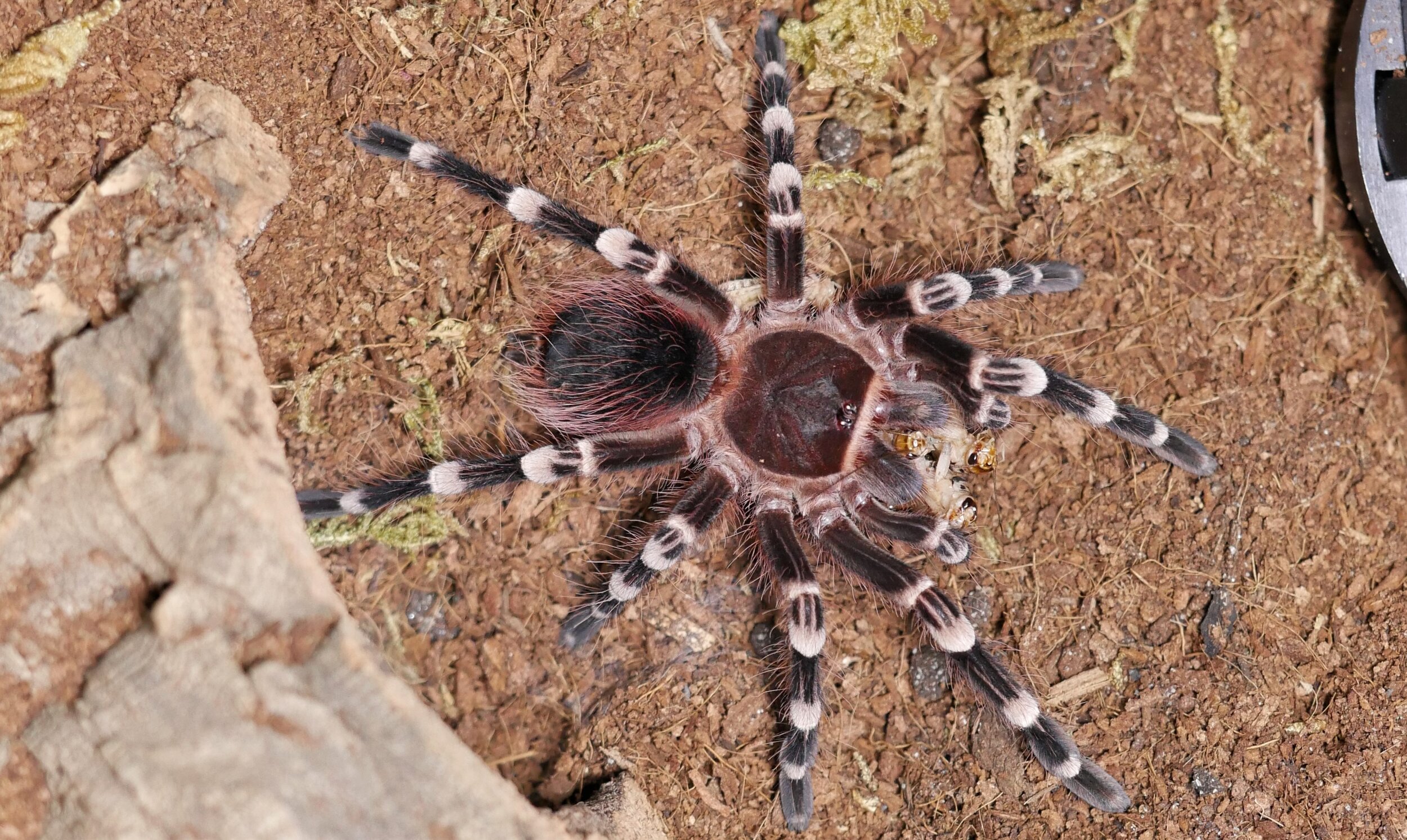Brazilian White Knee Tarantula (Acanthoscuria geniculata) Care Sheet

Care & Husbandry Video
This video shows you exactly how I keep and feed my Brazilian White Knee Tarantula. I show you the enclosures I use and the conditions I keep them from a spiderling to an adult tarantula. I also include some additional information on the Acanthoscuria geniculata.
Scientific Name: Acanthoscuria geniculata
Common Name: Brazilian Whiteknee Tarantula, Giant White Knee, Whitebanded Tarantula
Type: Terrestrial
Category: New World
Endemic Location: Brazil
Body Length: 3.5” (9cm)
Diagonal Leg Span (DLS): 8.25”(21cm)
Urticating Hairs: Yes Type I & III
Growth Rate: Fast
Life Expectancy: Females 20 years / Males 4 years
Recommended Experience Level: Beginner
Acanthoscurria geniculata or you may know it by its common names: Brazilian whiteknee tarantula , the Giant white knee or the Whitebanded tarantula. This is a fast growing New World Tarantula that comes from the Northern forests of Brazil. This species can reach up to a solid 8in leg span and has been know to reach nearly a 4in leg span in a year. Females of this species can live up to 20 years, though males tend to only live about 4 years on average. Being a NW species, this tarantula does have urticating hairs that can be quite irritating. And being a nervous and defensive T, they do not hesitate to kick them. This tarantula is would rather retreat to it’s hide when it feels threatened before threatening to bite, but it is prone to kick up some hairs while it is retreating. Be careful not to get these urticating hairs in your eyes, nose, or mouth as that can be very uncomfortable and possibly dangerous. This T is an aggressive eater and will pounce on any prey that enters its habitat with verocity and force making it one of my all time favorite feeding responses. The only time my whiteknees refuse food is when they are in premolt, and even then I have had some instances where slings and juveniles ate right up to a day or two before molting.
The husbandry for this species is pretty typical of all new world terrestrial t’s. They require an enclosure that provides more width than height. In fact, providing too much height to a heavy spider like this can be deadly. You don’t want the tarantula to be able to climb up the side of the enclosure to the top and have a long way to fall as they could easily rupture their abdomen and die. I usually fill my enclosures up at least half way with substrate, sometimes a little more, and provide a hide and a water dish. This T tends to enjoy burrowing deep into the substrate as slings, but even with a deep burrow, mine stays out in sight a lot of the time. As they grow larger they become less skittish and more prone to stay out on display. With their bright white bands contrasting against the deep black of this spider, they are a gorgeous and mesmerizing species. I keep their substrate dry but once a week I will over folw the water dish to ensure about a third or at least a corner of the enclosure has damp substrate but I let it dry out before i overflow the water dish again. The temperature I keep this tarantula at is the same as most of my other spiders, an average room temperature between 68-74 degrees. If you are comfortable, they are comfortable.
As far as feeding, I feed my spiderlings small crickets or roaches twice a week until the refuse food during pre-molt. If I do not have any prey small enough, I will prekill the prey before dropping it in and sometimes cut it in half and only feed them part. As they grow larger I provide a small-medium crickets or roaches no larger than its abdomen at least once a week and sometimes twice depending on their size and appetite. Once they're juveniles I will feed them 3 or 4 medium crickets at least once a week. And as adults I usually feed 8-15 large crickets or 2 or 3 large dubia roaches, sometimes a few more, at least once every couple of weeks depending on the size of the abdomen. This species is a very dramatic eater and quickly pounces on its prey, sometimes even rolling itself over in heat of the catch so it is exciting to watch it take down prey. The only time mine refuse a meal is when in pre-molt.
This is one of the species I am always sure to wear gloves and a long sleeved shirt when I am rehousing, unboxing, or cleaning out its enclosure. I find this species urticating hairs particularly irritating and try to avoid being exposed to them whenever possible. Bc of my sensitivity to this species hair, I do not handle my A. geniculata. That along with their nervous demeanor and propensity to quickly bolt when startled puts this T in the “look, but don’t touch” category for me.
Overall this is a gorgeous tarantula and a staple in the hobby. No collection is complete without one of these on display. Luckily they are usually very inexpensive and readily available. I think a few of mine I received as freebies when I placed an order for other tarantulas.






